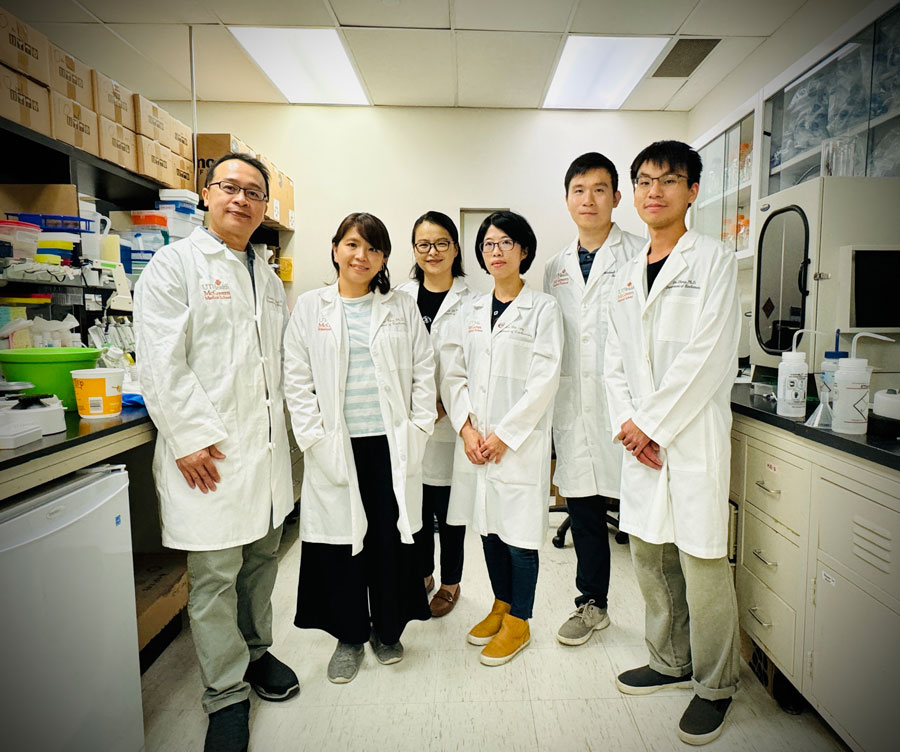Research reveals gene regulation breakthrough

Research from the Department of Biochemistry and Molecular Biology revealing a breakthrough in understanding gene regulation in human cells was published Oct. 17 in Molecular Cell.
“Structural basis of the human transcriptional Mediator regulated by its dissociable Kinase module” from lead author Kuang-Lei Tsai, PhD, assistant professor of biochemistry and molecular biology, furthers his prior research on yeast to human cells.
Tsai has employed cryogenic electron microscopy (cryo-EM) to determine the structures and mechanisms of eukaryotic transcription complexes since he was a postdoctoral fellow at the Scripps Research Institute.
“I am continually impressed by Dr. Tsai’s ability to clearly delineate fundamental biological questions related to the regulation of gene expression that are successfully addressed by the marvelous molecular structures of transcriptional machinery he determines,” said Rod Kellems, PhD, chair of the Department of Biochemistry and Molecular Biology and holder of the Bob and Hazel Casey Chair in Biochemistry. “Consistent with the phrase ‘a picture is worth a thousand words,’ Dr. Tsai’s beautiful molecular structures provide breakthrough discoveries enlightening our understanding of transcriptional regulation.”
In eukaryotic cells, gene expression is facilitated by a large molecular machine termed the mediator (MED) complex, composed of 30 subunits and with a molecular weight exceeding 1.5 million Daltons, Tsai explained.
MED plays a pivotal role in regulating gene transcription by transmitting regulatory signals from enhancers to the RNA polymerase II (Pol II) machinery. MED is comprised of a large core (cMED) and a dissociable CDK8 Kinase Module (CKM). The mediator complex functions by bridging activators and Pol II, regulating Pol II activity, and modulating the transcriptional response.
Tsai has been interested in the CKM module for over a decade and is especially intrigued with its relationship to a wide range of cancers including leukemias (92%), melanomas (76%), prostate cancers (29%) and colorectal cancers (26%), among others. Despite its medical importance, the structure of the human CKM, its mechanism of action, and the basis for oncogenic transformation are poorly understood.
“Our research reveals that CKM interacts with multiple regions of cMED and regulates its function in an unexpected manner,” Tsai said. “Combined with our earlier biochemical and functional analyses, this work provides a conserved structural framework that elucidates the basis for CKM-mediated repression of cMED function.”
Tsai’s research is supported through a CPRIT First Time Faculty Recruitment Award, a UT System Rising STARs Award, a grant from the Robert A. Welch Foundation, and two grants from the National Institutes of Health.
Additional authors from the Department of Biochemistry and Molecular Biology include Ti-Chun Chao, Shin-Fu Chen, Hui-Chi Tang, Tao Li, and Hsiang-Ching Tseng, and from the Department of Integrative Biology and Pharmacology, Dung-Fang Lee and Mo-Fan Huang. Collaborators also include from the Perelman School of Medicine, University of Pennsylvania Hee Jong Kim, Leon Palao, and Kenji Murakami; and from the University of Texas Health Science Center at San Antonio, Subash Khadka and Thomas Boyer.